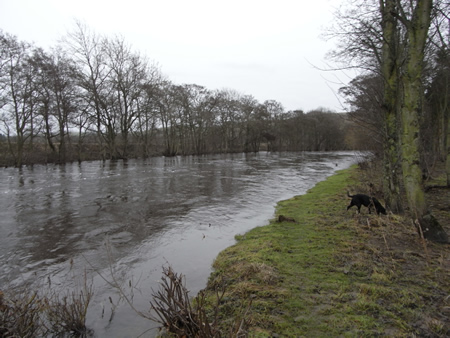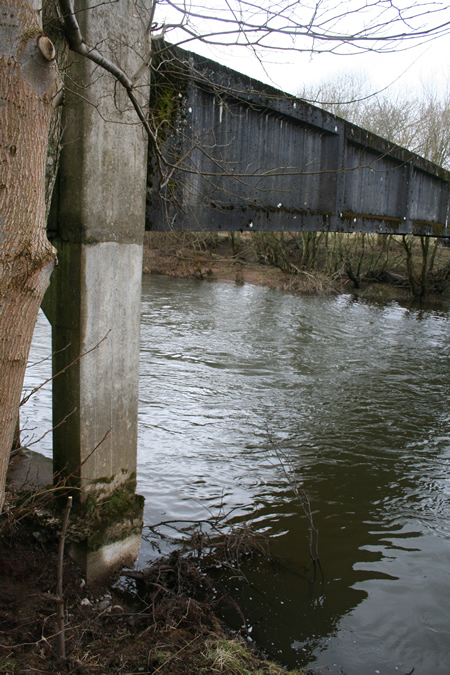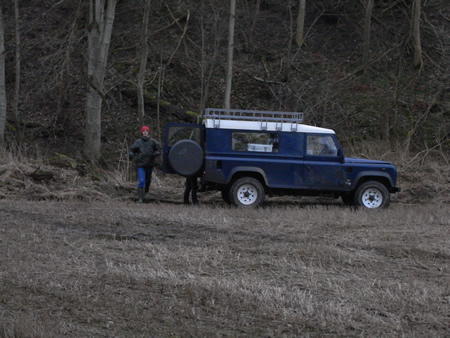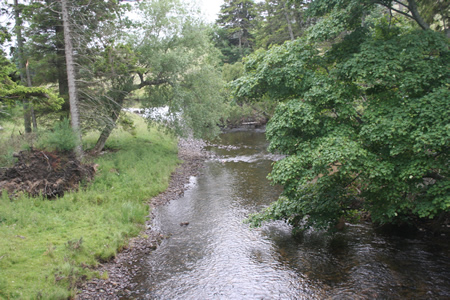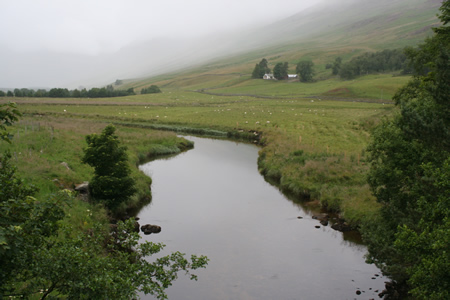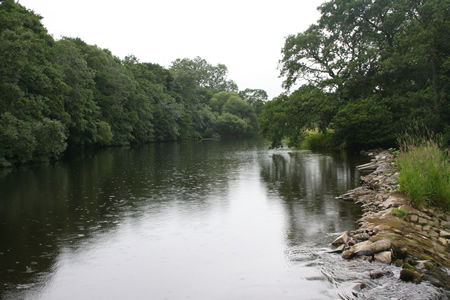These bulletin blogs represent news about Finavon and the South Esk, and my views as a riparian owner. They are not the views of any other organisation, nor are they designed to promote the interests of any individual or organisation other than Finavon Castle Water and factors affecting the fishery. Tony Andrews
The December spate was a big one: it was also powerful and did a fair bit of damage. But it didn’t bring the combination of melting snow, high winds and heavy rain driven by a South westerly gale that we had in January 1993. That was the biggest spate we have had in the last thirty years.
Winter at Finavon and high water in the Boat Pool
Talking to Angus Council and SEPA people, it is clear that much damage was done this year, with infrastructure degraded and some major erosion on the South Esk, but much worse on the North Esk, where huge erosion pockets and new cliffs have been formed, making it impossible for anglers to use sections of the banks on some beats.
At FCW we found that the Haughs Aqueduct was seriously undermined. Initially we thought it was in danger of collapsing, but after a meeting of experts on the riverbank on Tuesday 12th February we found that the heavily engineered structure is well supported by substantial foundations. With the overall weight of the aqueduct and its steel water pipe exceeding 100 tons, it would have been a major disaster had it fallen into the river, where it would almost certainly have become an obstacle to the passage of fish.
This is the right bank end of the Haughs Aqueduct after the winter spates removed most of the river bank on either side of the structure. At that point the river has a strong tendency to turn southwards into the Bogardo woods. Fortunately the structure is built on deep reinforced concrete foundations. Our job now is to work with SEPA and the Fishery Board to find a ‘soft engineering’ way of restoring the bank on each side of the aqueduct. We are looking at a range of environmentally sensitive options recommended by SEPA, and have arranged to meet their senior specialist on the river in march to discuss the way forward.
Radio Tagging Project 2013. I was pleased to meet Fran and James from Marine Scotland Science when they were positionoing the receivers for the 2013 tracking exercise. The two receivers at Finavon will be located in the same places as in 2012.
February 2013. The Marine Scotland (Montrose) field biologists position one of the receivers at Finavon to track our early running salmon.
The project will be done in much the same way as last year except that some salmon will, it is hoped, be netted in fresh water, probably at Kinnaird, about 8 miles downstream of FCW. Much will depend on water levels because it is not possible to net fish in the river in high water.
Judging by the huge amounts of snow in the glens and corries of the catchment there is little chance of there being extended periods of levels suitable for in-river netting. Two methods of netting in the river may be employed 1) a net set across the river 2) a moving net in much the same way as a net and coble operates. In-river netting will be done on one day each week where possible. All other salmon will be caught by the Usan nets, as they were in 2012, from where they will be tagged and released.
Prime juvenile habitat for salmon and trout in the upper reaches of the South Esk in Glen Clova.
A reflection on the 2012 project is perhaps useful at this point. 153 mainly two sea-winter salmon were tagged and released into the sea after being caught in coastal nets at Usan, just south of Montrose. About one third of these fish were later recorded by receivers placed on the South Esk, North Esk, Dee and Tay. A helicopter survey was carried out at the end of the season in the Don, Lunan and Earn catchments, which resulted in two tagged fish being identified in the River Don, north of Aberdeen. Both these fish had been tagged in September, and were not therefore likely to be from a target spring salmon population.
Other fish recorded by terrestrial receivers included 3 at sea, 19 in the North Esk, 18 in the South Esk, 8 in the Dee and 6 in the Tay. I have written separately about the wider implications of the Usan mixed stocks fishery in the Bulletin of December 12th 2012.
Glen Clova. This is the old ice age glacial lake floor, through which the upper river runs for about 10 miles. Natural erosion, assisted in places by some poor forestry drainage, continues here every year, generating huge amounts of gritty silt. In places, between the long quiet pools, there are gravel banks providing spawning opportunities, but they are few and far between. The deeper pools of Glen Clova are not fished hard and provide a virtual sanctuary for salmon as they await the winter floods to take them into the tributaries to spawn.
So, in the first year of three years of this fascinating project, about one third of all the salmon tagged were later picked up by receivers. The other 97 salmon disappeared, but that doesn’t mean they died. My friend and well known fishery scientist, Dr David Solomon, was a pioneer of radio tagging salmon on the Hampshire Avon in the 1970s and 1980s. He noted that salmon tagged in the early spring are more liable to regurgitate the radio transmitter than fish tagged later in the season. This may be attributable to the metabolism of the salmon still being operative, and the stomach not entirely atrophied in preparation for the salmon’s freshwater migration. Other tagged salmon may have been killed by predators, human or otherwise. The ‘wastage’ of about 65% is normal for tagging projects, so we can fairly describe the 2012 tagging and tracking operation as successful. Well done Julian and the MSS team!
The main purpose of the project was to identify spawning areas and juvenile habitat for the South Esk’s early running salmon. It was reassuring to see that Glen Clova, including the newly restored Rottal Burn (see 2012 summer bulletins), are providing spawning locations for our spring salmon. I understand from Marshall Halliday, the Director of the Esk Rivers Trust, that as many as 30 salmon spawned in the Rottal Burn. He also mentioned that some sea trout made use of the finer gravels near the confluence with the main stem of the river. The Rottal Burn clearly played its part in the regeneration of the South Esk’s migratory salmonids.
Year Two of the South Esk project starts on Saturday. I anticipate more of the same. It would be great if there were a big spring run into the South Esk as there was in 2011. That was the year when the Usan nets killed 2,307 spring salmon in the month of May, a fact which I argue is the basis for understanding that the South Esk’s spring salmon smolt output can, in the right circumstances, generate a strong spring run. As Colin Gibb of Inshewan said to me this morning, “the South Esk has always had erratic runs of salmon: a year of plenty followed by a year of scarcity. There’s nothing new in that” I think Colin is right. A small river is probably more dependent on good spawning conditions and parr survival than larger rivers. It is in the nature of small rivers that their surfeits and deficiences are more obvious than in bigger rivers. It is really a question of the size of the margins – call it a safety net if you like. Little rivers are, by their very nature, more prone to the effects of weather, flood and drought than their bigger neighbours.
I am not going to make an unfounded guess as to the abundance and quality in 2013 of the runs of salmon and sea trout into the South Esk because there are too many unknown variables to make a sensible estimate. What I can say from scientific evidence of monitoring the conditions in the North Atlantic Ocean, and from sampling salmon during their migrations, is that areas west of Iceland continue to offer salmon better feeding that in the NE Atlantic and Norwegian Sea. You only have to look at what is happening to mackerel, herring and blue whiting stocks to recognise that there is a lot of change going on at sea.
What do these data signify for the angler on the bank of the South Esk? Put very simply (and I know I shouldn’t) it means poor grilse runs, some grilse thin and small, but some (lucky) grilse may have fed in a richer patch of ocean, because it is not uniformly poor. In contrast, perhaps there will be more big fish, not many, but those that do make it back from the NW Atlantic should be in tip-top condition, if they don’t get snarled up in coastal nets, eaten by dolphins or seals, or taken by gill nets in the Ferryden estuary.
Great Sea Trout Water on the South Esk. This is Kintrockat, a few miles downstream of FCW.
As for sea trout, I am not going to try to predict how strong the 2013 runs will be, except to say that I am not unduly worried about their capacity to regenerate when conditions allow. South Esk sea trout are individually in great nick: there just haven’t been very many of them in recent years, at least not available to the angler! And there is nothing new in that, as 130 years of records at Finavon conclusively demonstrate.
TA
